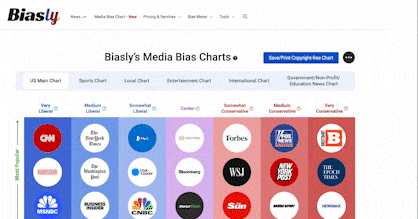 Los Angeles Times Article Rating
Los Angeles Times Article RatingThe real story of how L.A. became the epicenter of America's homeless crisis
- Bias Rating
- Reliability
70% ReliableGood
- Policy Leaning
-46% Medium Left
- Politician Portrayal
-51% Negative
Continue For Free
Create your free account to see the in-depth bias analytics and more.
By creating an account, you agree to our Terms and Privacy Policy, and subscribe to email updates.
Bias Score Analysis
The A.I. bias rating includes policy and politician portrayal leanings based on the author’s tone found in the article using machine learning. Bias scores are on a scale of -100% to 100% with higher negative scores being more liberal and higher positive scores being more conservative, and 0% being neutral.
Sentiments
N/A
- Liberal
- Conservative
| Sentence | Sentiment | Bias |
|---|---|---|
Unlock this feature by upgrading to the Pro plan. | ||
Reliability Score Analysis
Policy Leaning Analysis
Politician Portrayal Analysis
Bias Meter
Extremely
Liberal
Very
Liberal
Moderately
Liberal
Somewhat Liberal
Center
Somewhat Conservative
Moderately
Conservative
Very
Conservative
Extremely
Conservative
-100%
Liberal
100%
Conservative

Contributing sentiments towards policy:
65% : In 1980, it soared to No. 3 on the list, then, in 1990, to No. 1, where it has remained ever since.63% : In 1972, the U.S. Supreme Court ruled that criminal vagrancy laws, which allowed police to jail people for lingering on the streets, were unconstitutional.
59% : L.A. County Superior Court computers were spitting out 8,000 bench warrants a week for failure-to-appear charges, a 2014 state Supreme Court opinion said.
57% : This was the height of the Cold War, and anything that smacked of communism was taboo, especially in Los Angeles, whose politics were dominated by anti-communist conservatives.
56% : The 9th Circuit ruled in Martin vs. Boise in 2018 that cities could not enforce anti-camping ordinances if there were not enough shelter beds available to homeless people, in effect becoming the law in most of the West when the Supreme Court declined to take the case the next year.
52% : Measure H was expected to raise over $3.5 billion over 10 years, with the money going to a variety of anti-homelessness strategies.
48% : Since 1986, the primary federal financing to build affordable housing has come from the low-income housing tax credit, an indirect and remarkably inefficient program that gives tax breaks to banks and other institutions to back such projects.
47% : It is the predictable result of public policy.
46% : Susan Burton, founder of A New Way of Life Reentry Program and a national leader in criminal justice reform, said former inmates would step off the bus at the Greyhound station on 7th Street with nothing but a few dollars in their pockets and a list of Skid Row shelters.
45% : On the theory that strict policing of quality-of-life offenses such as public urination could turn around a blighted neighborhood, 50 extra officers were assigned to enforce a zero-tolerance policy on Skid Row.
41% : Fatal overdoses plateaued in 2023 but were still the leading cause of death — so much so that a homeless person was 46 times more likely to die of one than a member of the general population, according to the county Department of Public Health.
33% : By 1981-82, the U.S. economy plunged into recession, as the new Reagan administration was cutting social services, including Medicaid, food stamps, Aid for Families with Dependent Children and other programs.
*Our bias meter rating uses data science including sentiment analysis, machine learning and our proprietary algorithm for determining biases in news articles. Bias scores are on a scale of -100% to 100% with higher negative scores being more liberal and higher positive scores being more conservative, and 0% being neutral. The rating is an independent analysis and is not affiliated nor sponsored by the news source or any other organization.






















